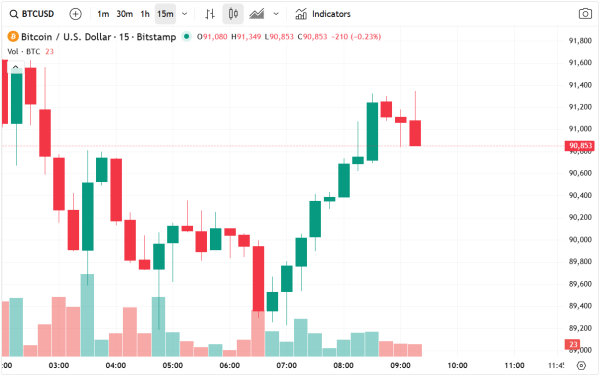Bitcoin (BTC) has seen a steep decline in recent months, a downtrend that intensified this week. The BTC/USD pair dropped sharply from its October peak of $126,300 to under $91,000, erasing a large portion of gains from earlier in the year.
Traders, investors, and analysts are closely monitoring the situation, as the cryptocurrency market faces increasing volatility, bearish momentum, and declining market confidence. In this article, LFtrade brokers take a closer look at the key aspects of the topic.
Bitcoin Price Collapse Amid Market Optimism
Despite ongoing political clarity, institutional support, and Wall Street backing, Bitcoin’s price has suffered a steep decline. Its market capitalization has shrunk by over $600 billion from the November high, signaling the most substantial drawdown this year. This stark reversal highlights the inherent risk and volatility of the BTC/USD market and underscores the challenges facing crypto traders in navigating extreme price swings.
The Crypto Fear and Greed Index has plunged to 16, entering the extreme fear zone, the lowest reading since April. During that period, market uncertainty spiked when the US President announced reciprocal tariffs on all countries. The correlation between the Index and Bitcoin price suggests that investor sentiment remains a critical driver of BTC/USD price action.
ETF Outflows Weigh on Bitcoin
Adding to the bearish pressure, Bitcoin exchange-traded funds (ETFs) have seen rising outflows. According to data from SoSoValue, all spot Bitcoin ETFs lost over $1.2 billion in assets last week, a trend continuing this week. Notably, BlackRock’s IBIT ETF now holds around $74 billion, down from nearly $100 billion earlier this month.
The outflows from major ETFs indicate that investors are withdrawing capital amid uncertainty, increasing selling pressure on Bitcoin. This trend can exacerbate downward momentum, as institutional participants often serve as stabilizing forces in crypto markets.
Corporate Treasuries Adjust Positions
Corporate Bitcoin treasury companies have mostly halted accumulation, with exceptions like Michael Saylor’s Strategy. Strategy surprised market observers by purchasing 8,178 BTC for $835 million last week, signaling confidence amid widespread bearish sentiment. Other companies have seen their stock valuations decline, contributing to reduced buying activity and heightened market caution.

BTC/USD Price Outlook Ahead of Fed Minutes
Looking forward, the BTC/USD pair is poised to react to the upcoming Federal Reserve minutes scheduled for Wednesday. These minutes are expected to provide insights into monetary policy direction and interest rate expectations. The falling odds of a Fed rate cut in December have been identified as a primary catalyst for Bitcoin’s recent crash, highlighting the sensitivity of crypto markets to macroeconomic developments.
BTC/USD Technical Analysis
A technical review of Bitcoin shows bearish signals dominating the charts. On the daily timeframe, BTC/USD has fallen from $126,275 in October to a recent low of $91,900.
The pair has already breached the critical support level at $107,275, previously the lowest point in August and the neckline of a double-top pattern. Breaching this level confirms bearish momentum and indicates that sellers remain firmly in control.
Death Cross Pattern Signals More Downside
Bitcoin has also formed a death cross, where the 50-day Exponential Moving Average (EMA) crosses below the 200-day EMA. This technical pattern often signals short-term downward pressure and suggests that BTC/USD could continue its downtrend.
Supertrend Indicator Confirms Bearish Control
The BTC/USD pair continues to trade beneath the Supertrend indicator, signaling that sellers maintain control over the market. As a result, technical indicators suggest that Bitcoin is likely to test the next key support level at $88,790, previously the highest level in March. A sustained move below this level could trigger further panic selling and deepen the market decline.

Summary and Trading Implications
In summary, the BTC/USD pair is experiencing one of the most significant corrections of the year, driven by a combination of ETF outflows, declining market sentiment, and the anticipation of Federal Reserve policy updates. The breach of critical support levels, coupled with the death cross and Supertrend signals, indicates that short-term downside risks remain high.
Traders should watch BTC/USD support and resistance levels at $91,900, $88,790, and $107,275, monitor the Crypto Fear and Greed Index, track ETF inflows and outflows, especially BlackRock’s IBIT, and review Federal Reserve minutes for signs of monetary policy changes.
Given the current technical indicators and market dynamics, the BTC/USD pair may continue to face selling pressure, making risk management essential for both short-term traders and long-term investors.
Bitcoin’s ongoing price correction serves as a reminder of the volatile nature of crypto markets, where institutional support and macroeconomic signals can no longer fully shield the market from sharp drawdowns. Traders must remain vigilant and adapt to rapidly changing market conditions as the BTC/USD pair searches for stability.







